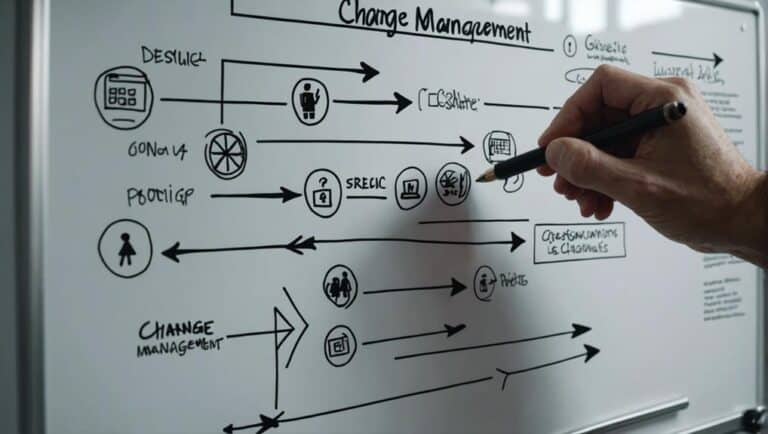Imagine a global tech company that decides to implement a new software system across all its departments simultaneously. As you know, change can be challenging for any organization, especially on such a large scale.
How did they navigate potential pitfalls and ensure a smooth transition? The strategies and principles they employed in their change management process offer valuable insights for any organization looking to drive successful organizational development through effective change management practices.
Key Takeaways
- Conducting change readiness assessments enhances organizational development.
- Transparent communication and proactive concern addressing foster organizational growth.
- Implementing clear change tactics aligns with organizational development goals.
- Engaging employees through workshops and collaborative projects drives organizational development.
Importance of Change Management
In today's dynamic business environment, understanding the importance of change management is crucial for organizational success and growth. Change management offers numerous benefits to companies striving to adapt and thrive in a constantly evolving landscape. By effectively implementing change management strategies, organizations can increase employee engagement, improve productivity, and foster innovation. Embracing change also allows businesses to stay competitive, respond to market trends swiftly, and enhance their overall performance.
However, despite the many benefits, organizations often face significant challenges when implementing change management initiatives. Resistance to change from employees, lack of clear communication, and inadequate leadership support are common hurdles that can impede the success of change efforts. Overcoming these challenges requires a strategic approach that involves engaging stakeholders, providing adequate training, and creating a supportive organizational culture that embraces change as a constant and necessary element for growth. By addressing these challenges proactively, companies can maximize the benefits of change management and drive sustainable organizational development.
Key Principles in Change Management
Implementing key principles in change management requires a strategic and methodical approach to drive organizational transformation effectively. To begin, conducting a change readiness assessment is crucial in understanding the organization's current state, potential barriers, and readiness for change. This assessment informs the development of tailored training programs to equip employees with the necessary skills and knowledge to navigate the upcoming changes successfully.
Change leadership plays a pivotal role in change management. Strong and visible leadership ensures alignment with the organizational vision, fosters a culture of adaptability, and inspires employees to embrace the change. Additionally, gaining stakeholder buy-in is essential for the smooth implementation of change initiatives. Engaging stakeholders early, communicating transparently, and addressing concerns proactively can help build support and mitigate resistance.
Practices for Successful Change Implementation
To successfully implement change within your organization, focus on key change strategies and employee engagement techniques. These practices are crucial in ensuring that the transition is smooth and well-received by your team.
Key Change Strategies
During the process of organizational change, identifying and utilizing key change strategies is crucial for successful implementation and adaptation within the dynamic business environment. Change tactics play a vital role in navigating transitions effectively. It's essential to have clear and well-communicated change tactics that align with the overall organizational goals.
Leadership support is another critical aspect in implementing change strategies. Leaders must champion the change, providing guidance, resources, and motivation to ensure a smooth transition. Effective leadership support can inspire confidence among employees, fostering a positive attitude towards change.
Employee Engagement Techniques
Engage employees through interactive workshops and collaborative projects to foster a culture of active participation and commitment during change initiatives. When implementing change, utilizing motivation techniques and feedback mechanisms can significantly enhance employee engagement.
Here are three key practices to consider:
- Regular Feedback Sessions: Conduct frequent feedback sessions to gather insights, address concerns, and show employees that their opinions are valued.
- Recognition and Rewards: Implement a system that recognizes and rewards employees for their contributions and efforts during the change process.
- Skill Development Opportunities: Provide employees with training and development opportunities that align with the changes being made, empowering them to adapt and grow within the organization.
Managing Resistance to Change
Resistance to change in organizations often stems from a fear of the unknown and a perceived loss of control. Overcoming challenges related to managing resistance requires a strategic approach that focuses on building support among employees. To address resistance effectively, start by communicating openly and transparently about the reasons behind the change. Providing a clear vision and rationale can help employees understand the necessity of the changes and alleviate uncertainties.
Additionally, involving employees in the change process can foster a sense of ownership and empowerment, making them more likely to support the initiatives. Encouraging open dialogue and feedback channels can also help in addressing concerns and gaining valuable insights from the workforce. Recognizing and acknowledging the valid concerns of employees demonstrates empathy and can go a long way in building trust and cooperation. By actively involving employees, addressing their fears, and providing adequate support and resources, organizations can navigate resistance to change more effectively and pave the way for successful implementation.
Communication Strategies for Change
To effectively drive organizational change, implementing targeted communication strategies is essential for ensuring clarity, alignment, and employee engagement in the transformation process. Effective messaging plays a crucial role in conveying the reasons behind the change, the benefits it will bring, and the steps involved in the transition. Stakeholder involvement is another key aspect to consider. Engaging stakeholders early on, listening to their feedback, and addressing their concerns can foster a sense of ownership and commitment to the change initiative.
Key Strategies for Effective Communication:
- Tailored Messaging: Customize communication based on the needs and preferences of different employee groups to ensure relevance and resonance.
- Multi-Channel Approach: Utilize various communication channels such as meetings, emails, intranet, and workshops to reach a diverse workforce and reinforce key messages.
- Feedback Mechanisms: Establish feedback loops to encourage open dialogue, gather insights, and address any misconceptions or resistance promptly.
Evaluating Change Management Success
Assessing the effectiveness of change management is crucial to determining the success of organizational transformation efforts. When evaluating effectiveness, consider measuring impact in various ways. Start by examining if the intended goals and objectives of the change initiative were met. This involves scrutinizing key performance indicators to gauge progress and outcomes.
Additionally, assess the level of employee engagement and satisfaction post-change implementation. High levels of engagement often indicate successful change adoption.
Measuring impact also involves analyzing any shifts in organizational culture and whether they align with the desired changes. Look at how well the new processes have been integrated into daily operations and if they've resulted in improved efficiency or productivity.
Furthermore, evaluating the financial implications of the change is essential. Determine if the investment in change management has yielded a positive return on investment. By thoroughly evaluating these aspects, you can gain valuable insights into the overall success of the change management process and make informed decisions for future organizational development initiatives.
Frequently Asked Questions
How Can Organizational Culture Impact the Success of Change Management Initiatives?
Your organization's culture significantly influences change management success. By understanding organizational dynamics and recognizing the impact of leadership, you can foster a culture that embraces change, increasing the likelihood of successful initiatives.
What Role Do Middle Managers Play in Driving Change Within an Organization?
Middle managers are pivotal in driving change within organizations. With leadership support, they execute strategies, communicate effectively, and bridge the gap between higher management and frontline employees. Their role is crucial in fostering successful organizational transformations.
How Can External Factors Like Industry Trends or Technological Advancements Influence the Need for Change Management?
In the fast-paced world of business, external factors like industry trends and technological advancements can profoundly impact your organization's need for change management. Adapting to these shifts can mean the difference between thriving or falling behind.
What Are Some Common Pitfalls to Avoid When Implementing Change Management Strategies?
When implementing change management strategies, avoid common pitfalls like underestimating resistance and neglecting effective communication. Resistance can hinder progress, and clear communication is essential for ensuring buy-in and successful implementation of changes within your organization.
How Can Organizations Sustain the Changes Made Through Change Management in the Long Term?
Embrace the essence of change sustainability. Engage your employees passionately. Success in the long term hinges on unwavering leadership commitment. Make it a journey where every step forward is a testament to your dedication.
Conclusion
In conclusion, effective change management is like navigating a ship through rough waters – it requires a clear strategy, strong leadership, and proactive communication.
By following key principles, implementing best practices, addressing resistance, and evaluating success, organizations can successfully navigate through change and achieve their desired outcomes.
Remember, change is inevitable, but with the right approach, it can lead to growth and development for the organization.





